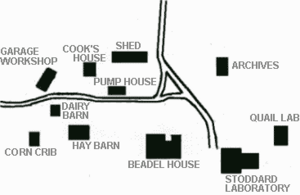Tall Timbers Research Station and Land Conservancy facts for kids
30°39′23″N 84°12′32″W / 30.6565°N 84.20875°W The Tall Timbers Research Station and Land Conservancy is a special place in northern Leon County, Florida. It's a center for learning and scientific studies. You can find it near Lake Iamonia. Scientists here study many things about nature. They look at how fire affects forests, how to manage land, and how to care for birds and other animals.
This research station used to be a large farm. It was called Tall Timbers Plantation. It was built way back in 1895 by Edward Beadel. People used to hunt quail there.
Contents
Learning About Fire in Nature
The Fire Ecology Program helps people understand how to use prescribed fire. Prescribed fire means setting small, controlled fires on purpose. These fires help the forest grow healthy. The program shares scientific information about how fire and plants work together. This is especially important in the southern pine forests of the Red Hills Region.
Taking Care of the Land
The Resource Management Program is in charge of keeping the land healthy. They make sure the forests stay open and look like parks. They use different methods to do this. These include prescribed fire, special tools, and even some chemicals. All these methods help them reach their goals for land care.
The Forestry Program also works on managing forests. They research the best ways to take care of trees and woodlands. Their work focuses on the Red Hills Region. This area is located between Tallahassee, Florida and Thomasville, Georgia.
Studying Game Birds
The Game Bird Program studies birds that people might hunt. They focus on the northern bobwhite quail (Colinus virginianus). They learn about where these quails live and what they need to survive. This helps protect their homes.
Exploring Animal Life
The Vertebrate Ecology Lab studies different animals that have backbones. These animals are called vertebrates. The lab looks closely at birds like Bachman's sparrows, brown-headed nuthatches, and red-cockaded woodpeckers. Their research helps us understand these animals better.


